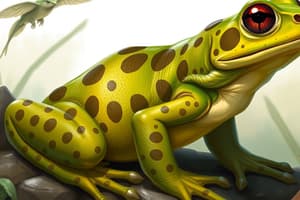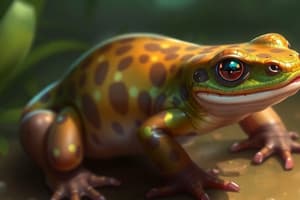Podcast
Questions and Answers
What type of glands do members of the Salamandridae family have in their skin?
What type of glands do members of the Salamandridae family have in their skin?
- Toxic glands
- Pheromone glands
- Venomous glands
- Poisonous glands (correct)
How do aquatic salamanders that lack hind limbs swim?
How do aquatic salamanders that lack hind limbs swim?
- By undulating their bodies in a wavelike manner (correct)
- By kicking their front legs
- By using their front legs like paddles
- By using their tail like a rudder
What is a behavioral adaptation of salamanders to survive the winter months?
What is a behavioral adaptation of salamanders to survive the winter months?
- Hibernation (correct)
- Migration
- Camouflage
- Active hunting
Why do land-dwelling salamanders require a damp habitat?
Why do land-dwelling salamanders require a damp habitat?
How do some aquatic salamanders breathe?
How do some aquatic salamanders breathe?
When are salamanders typically active?
When are salamanders typically active?
What is a characteristic feature of salamanders' skin?
What is a characteristic feature of salamanders' skin?
What is the primary function of the bright colors exhibited by some salamander species?
What is the primary function of the bright colors exhibited by some salamander species?
What is the range of lengths for average salamanders?
What is the range of lengths for average salamanders?
What is unique about the breathing habits of some salamanders?
What is unique about the breathing habits of some salamanders?
What is the typical habitat requirement for salamanders?
What is the typical habitat requirement for salamanders?
What is the name of the family of salamanders that includes newts?
What is the name of the family of salamanders that includes newts?
What is the primary function of salamanders' poisonous skin glands?
What is the primary function of salamanders' poisonous skin glands?
Which of the following is an example of a salamander's defensive posture?
Which of the following is an example of a salamander's defensive posture?
What is the purpose of tail lashing in some salamanders?
What is the purpose of tail lashing in some salamanders?
How do aquatic salamanders capture their prey?
How do aquatic salamanders capture their prey?
What is a unique feature of some salamanders' tongues?
What is a unique feature of some salamanders' tongues?
What can salamanders regenerate?
What can salamanders regenerate?
What is the process by which salamanders capture their prey?
What is the process by which salamanders capture their prey?
Where do salamanders typically lay their eggs?
Where do salamanders typically lay their eggs?
How many eggs can salamanders lay at one time?
How many eggs can salamanders lay at one time?
What is unique about the larval stage of salamanders?
What is unique about the larval stage of salamanders?
How do some species of salamanders undergo fertilization?
How do some species of salamanders undergo fertilization?
What is the main difference between the life cycles of salamanders and newts?
What is the main difference between the life cycles of salamanders and newts?
Flashcards are hidden until you start studying
Study Notes
Salamanders' General Features
- Salamanders are a group of amphibians characterized by their lizard-like appearance, long and slender bodies, moist and smooth skin, and long tails.
- They are very diverse, with some having four legs, some having two, and some having lungs, gills, or neither (breathing through their skin).
- Salamanders' permeable skin makes them reliant on habitats in or near water or other cool, damp places.
Size and Coloration
- Average salamanders are between 4 to 6 inches (10 to 15 centimeters) in length, but can vary greatly depending on species.
- The pygmy salamander (Desmognathus wrighti) is one of the smallest, measuring 1.5 to 2 inches (3.8 to 5.1 centimeters) in length.
- The Chinese giant salamander (Andrias davidianus) is the largest, growing up to 5.9 feet (1.8 meters) in length.
- Some species exhibit bold colors and patterns, serving as a warning to potential predators.
Reproduction
- Salamanders reproduce by laying round eggs coated with a protective, jelly-like material, with 20 to 500 eggs laid in one cluster.
- Eggs are laid underwater in chambers, upon vegetation, on the roof of the female's shelter, or under stones.
- Fertilization can be external or internal, depending on the species.
Life Cycle
- After birth, almost all salamanders go through a larval stage of development before reaching adulthood.
- The metamorphosis period, similar to a frog's development as a tadpole, can last from a few days to many years.
- Typical larval features include external gills, teeth in both jaws, and no eyelids.
Locomotion and Behavior
- Land-dwelling salamanders walk on all four legs with a side-to-side motion, moving diagonally opposite feet in the same direction.
- Aquatic salamanders swim by undulating their bodies in a wavelike manner, or use webbed hind feet and a specially adapted tail.
- Salamanders are normally active in the evening (nocturnal) and hibernate during the winter months in regions where the temperature falls below freezing.
Defensive Behavior
- Salamanders have poisonous skin glands that secrete potent toxins, which serve as a deterrent to predators.
- They can defend themselves by striking out at predators with their tails, which are concentrated with toxins.
- Salamanders can also regenerate lost body parts, such as tails and digits.
Feeding
- Salamanders feed on insects, worms, small fish, snails, and crustaceans.
- Some species are cannibalistic and eat members of their own kind.
- Land-dwelling salamanders capture prey by flicking out their tongues, while aquatic salamanders use a suction method.
Studying That Suits You
Use AI to generate personalized quizzes and flashcards to suit your learning preferences.




